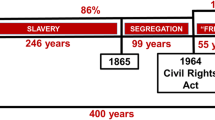Abstract
The primary aim of this study was to examine whether incarceration during pregnancy is associated with infant birthweight. Our second objective was to illustrate the sensitivity of the relationship between infant birthweight and exposure to prison during pregnancy to the method used to measure and model this exposure. The data consisted of delivery records of 360 infants born between January 1, 2002 and December 31, 2004 to pregnant women incarcerated in Texas state prisons. Weighted linear regression, adjusting for potential confounders, was used to model infant birth weight as a function of: (1) the number of weeks of pregnancy spent incarcerated (Method A) and (2) the gestational age at admission to prison (Method B), respectively. These two exposure measures were modeled as continuous variables with and without linear spline transformation. The association between incarceration during pregnancy and infant birthweight appears strongest among infants born to women incarcerated during the first trimester and very weak to non-existent among infants born to women incarcerated after the first trimester. With Method A, but not Method B, linear spline transformation had a distinct effect on the shape of the relationship between exposure and outcome. The association between exposure to prison during pregnancy and infant birth weight appears to be positive only among women incarcerated during the first trimester of pregnancy and the relation is sensitive to the method used to measure and model exposure to prison during pregnancy.



Similar content being viewed by others
References
Beck, A., & Harrison, P. (2005). Bureau of Justice statistics bulletin: Prisoners in 2004 (publication no: NCJ 210677). Washington, DC: U.S. Department of Justice.
Fogel, C. I., & Harris, B. G. (1986). Expecting in prison: Preparing for birth under conditions of stress. Journal of Obstetric, Gynecologic, and Neonatal Nursing, 15, 454–458.
Elton, P. (1988). Mothers and babies in prison. British Journal of Hospital Medicine, 40, 9.
Philipp, E. (1988). Pregnancy in women prisoners. British Journal of Hospital Medicine, 40, 150.
Cordero, L., Hines, S., Shibley, K. A., & Landon, M. B. (1991). Duration of incarceration and perinatal outcome. Obstetrics and Gynecology, 78, 641–645.
Martin, S. L., Kim, H., Kupper, L. L., Meyer, R. E., & Hays, M. (1997). Is incarceration during pregnancy associated with infant birthweight? American Journal of Public Health, 87, 1526–1531.
Martin, S. L., Rieger, R. H., Kupper, L. L., Meyer, R. E., & Qaqish, B. F. (1997). The effect of incarceration during pregnancy on birth outcomes. Public Health Reports, 112, 340–346.
Bell, J. F., Zimmerman, F. J., Cawthon, M. L., Huebner, C. E., Ward, D. H., & Schroeder, C. A. (2004). Jail incarceration and birth outcomes. Journal of Urban Health, 81, 630–644.
Greenland, S. (1995). Dose-response and trend analysis in epidemiology: Alternatives to categorical analysis. Epidemiology, 6, 356–365.
Wilcox, A. J. (2001). On the importance–and the unimportance–of birthweight. International Journal of Epidemiology, 30, 1233–1241.
Low, J. A., & Galbraith, R. S. (1974). Pregnancy characteristics of intrauterine growth retardation. Obstetrics and Gynecology, 44, 122.
Streeter, G. L. (1920). Weight, sitting height, head size, foot length and menstrual age of the human embryo. Contributions to Embryology, 11, 143.
Widdowson, E. M. (1968). Growth and composition of the fetus and new-born. In N. S. Assale (Ed.), Biol of gestation (pp. 40–43). NY: Academic Press.
Cohen, G. R., Curet, L. B., Levine, R. J., Ewell, M. G., Morris, C. D., Catalano, P. M., et al. (2001). Ethnicity, nutrition and birth outcomes in nulliparous women. American Journal of Obstetrics and Gynecology, 185, 660–667.
Cuco, G., Arija, V., Iranzo, R., Vila, J., Prieto, M. T., & Fernandez-Ballart, J. (2006). Association of maternal protein intake before conception and throughout pregnancy with birthweight. Acta Obstetricia et Gynecologica Scandinavica, 85, 413–421.
Godfrey, K., Robinson, S., Barker, D. J. P., Osmond, C., & Cox, V. (1996). Maternal nutrition in early and late pregnancy in relation to placental and fetal growth. BMJ, 312, 410–414.
Neggers, Y. H., Goldenberg, R. L., Tamura, T., Cliver, S. P., & Hoffman, H. J. (1997). The relationship between maternal dietary intake and infant birthweight. Acta Obstetricia et Gynecologica Scandinavica, 165, 71–75.
Shankaran, S., Das, A., Bauer, C. R., Bada, H. S., Lester, B., Wright, L. L., et al. (2004). Association between patterns of maternal substance use and infant birth weight, length, and head circumference. Pediatrics, 114(2), e226–e234.
Mariscal, M., Palma, S., Llorca, J., Pérez-Iglesias, R., Pardo-Crespo, R., & Delgado-Rodríguez, M. (2006). Pattern of alcohol consumption during pregnancy and risk for low birth weight. Annals of Epidemiology, 16(6), 432–438. Epub 2005 Oct 27.
Howard, D. L., Strobino, D., Sherman, S., & Crum, R. (2008). Within prisons, is there an association between the quantity of prenatal care and infant birthweight? Paediatric and Perinatal Epidemiology, 22(4), 369–378.
Acknowledgments
We are indebted to John Pulvino and Dr. Owen Murray from the Correctional Managed Care division of the University of Texas-Medical Branch for their assistance in accessing and abstracting the medical and delivery records of the women in our study. We are also grateful to Dr. Darrell Gaskin and Dr. Brad Astor for their comments in the preparation of this manuscript.
Author information
Authors and Affiliations
Corresponding author
Rights and permissions
About this article
Cite this article
Howard, D.L., Strobino, D., Sherman, S.G. et al. Maternal Incarceration During Pregnancy and Infant Birthweight. Matern Child Health J 15, 478–486 (2011). https://doi.org/10.1007/s10995-010-0602-y
Published:
Issue Date:
DOI: https://doi.org/10.1007/s10995-010-0602-y




